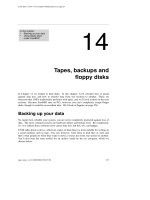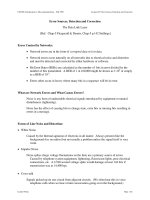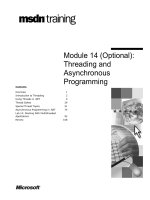Lecture Connections 14 | Glucose Utilization and Biosynthesis
Bạn đang xem bản rút gọn của tài liệu. Xem và tải ngay bản đầy đủ của tài liệu tại đây (4.58 MB, 86 trang )
Lecture Connections
14 | Glucose Utilization and Biosynthesis
© 2009 W. H. Freeman and Company
CHAPTER 14
Glucose Utilization and Biosynthesis
Key topics:
– Harnessing energy from glucose via glycolysis
– Fermentation under anaerobic conditions
– Synthesis of glucose from simpler compounds:
gluconeogenesis
– Oxidation of glucose in pentose phosphate
pathway
Central Importance of Glucose
• Glucose is an excellent fuel
– Yields good amount of energy upon oxidation
– Can be efficiently stored in the polymeric form
– Many organisms and tissues can meet their energy
needs on glucose only
• Glucose is a versatile biochemical precursor
– Bacteria can use glucose to build the carbon skeletons
of:
•
•
•
•
All the amino acids
Membrane lipids
Nucleotides in DNA and RNA
Cofactors needed for the metabolism
Four Major Pathways of Glucose
Utilization
• When there’s plenty of excess energy, glucose can
be stored in the polymeric form (starch, glycogen)
• Short-term energy needs are met by oxidation of
glucose via glycolysis
• Pentose phosphate pathway generates NADPH that
is used for detoxification, and for the biosynthesis of
lipids and nucleotides
• Structural polysaccharides (e.g. in cell walls of
bacteria, fungi, and plants) are derived from glucose
Glycolysis: Importance
• Glycolysis is a sequence of enzyme-catalyzed reaction
by which glucose is converted into pyruvate
• Pyruvate can be further aerobically oxidized
• Pyruvate can be used as a precursor in biosynthesis
• In the process, some of the oxidation free energy in
captured by the synthesis of ATP and NADH
• Research of glycolysis played a large role in the
development of modern biochemistry
– Understanding the role of coenzymes
– Discovery of the pivotal role of ATP
– Development of methods for enzyme purification
– Inspiration for the next generations of biochemists
Glycolysis: Overview
• In the evolution of life, glycolysis probably was one
of the earliest energy-yielding pathways
• It developed before photosynthesis, when the
atmosphere was still anaerobic
• Thus, the task upon early organisms was how to
extract free energy from glucose anaerobically?
•The solution
–Activate it first by transferring couple of
phosphates to it
–Collect energy later form the high-energy
metabolites of the activated glucose
Glycolysis: The Preparatory Phase
Glycolysis: The Payoff Phase
The Hexokinase Reaction
• The first step, phosphorylation of glucose, is
catalyzed by hexokinase in eukaryotes, and by
glucokinase in prokaryotes
• Nucleophilic oxygen at C6 of glucose attacks the
last () phosphorous of ATP
• Bound Mg++ facilitates this process by stabilizing
the negative charge in the transition state
• This process uses the energy of ATP
Phosphohexose Isomerization
• An aldose can isomerize into ketose via an
enediol intermediate
• The isomerization is catalyzed by the active-site
glutamate
• In one step, ionized Glu acts as a general base to
abstract the proton from C2 and generate the
enediol
• In the next step, protonated Glu acts as a general
acid to re-protonate enediol at C1
Mechanism of Phosphohexose
Isomerase
The Second Priming Reaction;
The First Commitment
• ATP is the donor of the second phosphate group
• This is an irreversible step
• The product, fructose 1,6-bisphosphate is
committed to become pyruvate and yield energy
• Phosphofructokinase-1 is negatively regulated by
ATP
– Do not burn glucose if there is plenty of ATP
Aldolases Cleave 6-Carbon Sugars
• The reverse process is the familiar aldol
condensation
• Animal and plant aldolases employ covalent
catalysis
• Fungal and bacterial aldolases employ metal ion
catalysis
Covalent Catalysis in Class I
Aldolases









